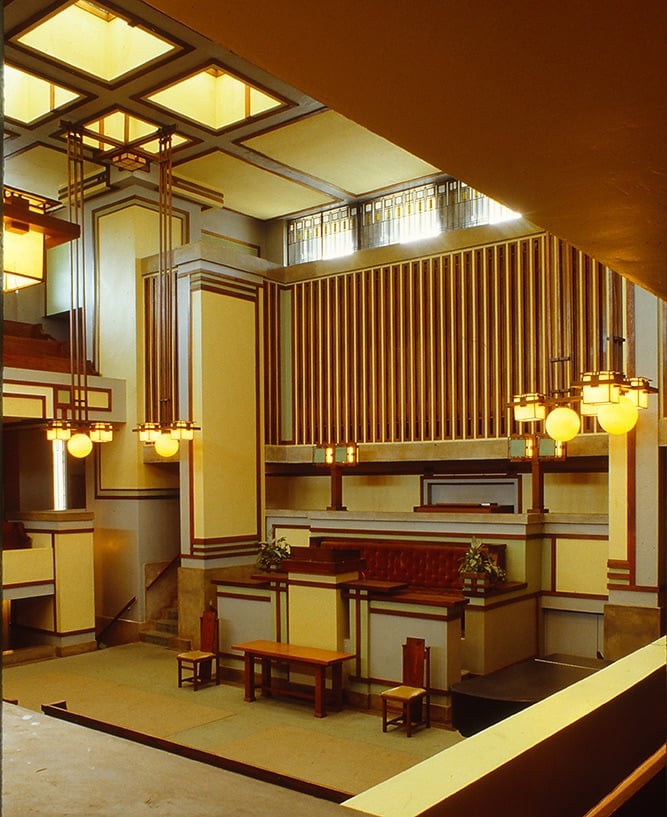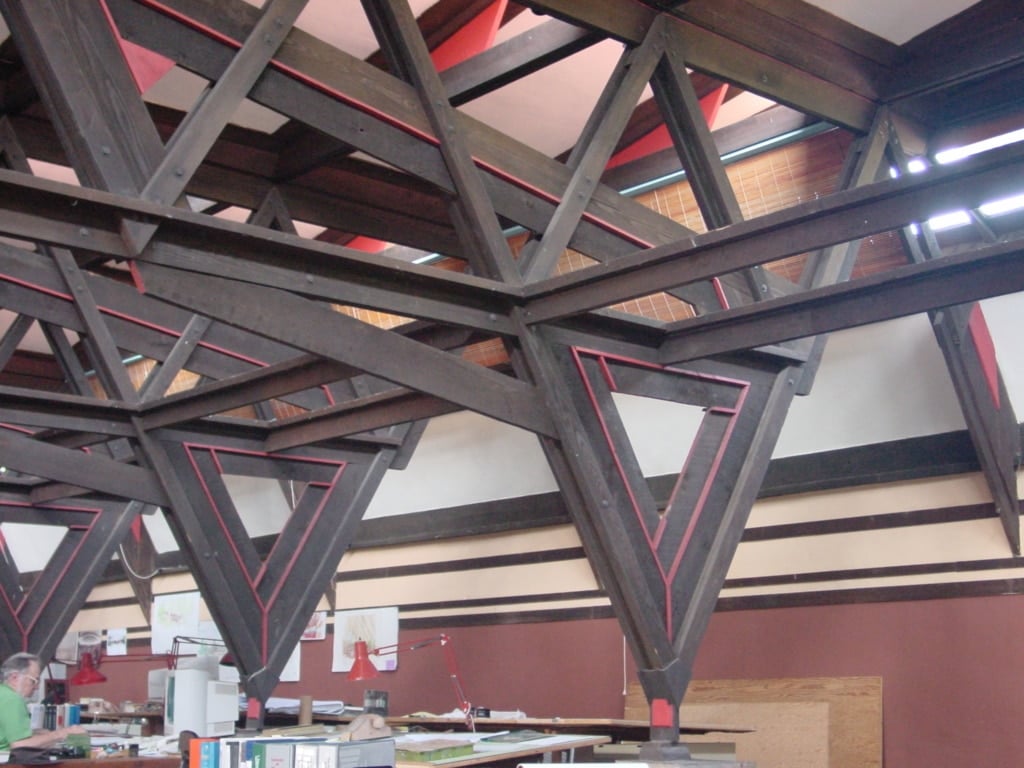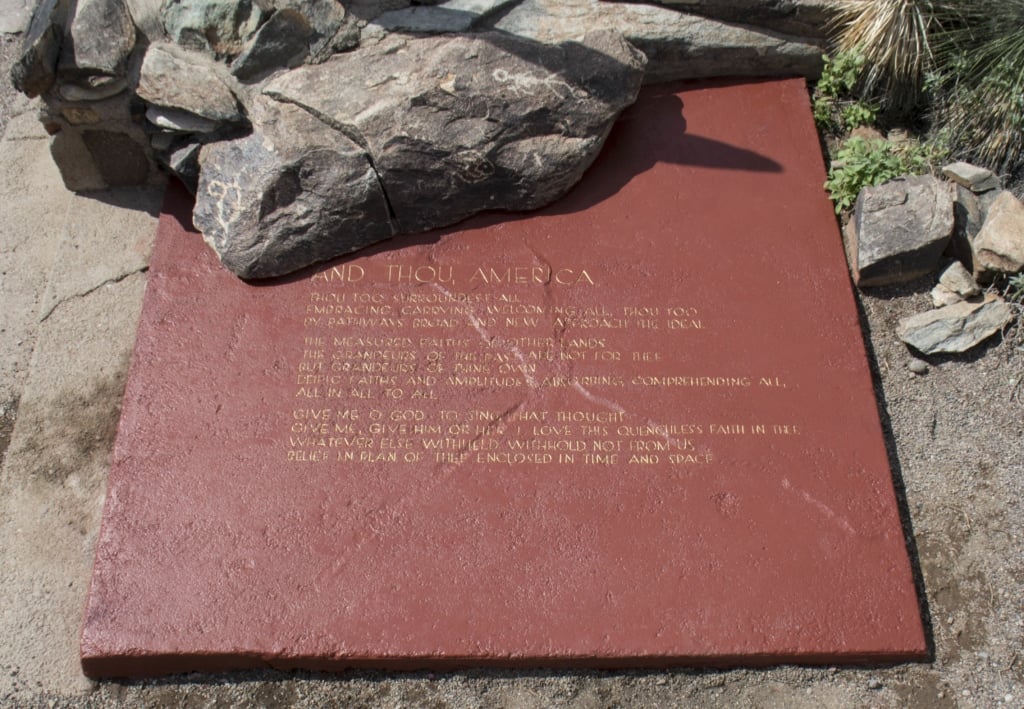

Frank Lloyd Wright, Transcendentalism, and Organic Architecture
BY Naomi Tanabe Uechi
In order to understand Frank Lloyd Wright’s works, two concepts are essential: Transcendentalism and organic architecture. Transcendentalism refers to a 19th century school of American thought. It connected the philosophy and literary ideas of Romanticism with Unitarianism, which denied the Christian doctrines of the Trinity, original sin, the miracles and deity of Jesus Christ, and everlasting punishment. Transcendentalism respected equally Nature and the Human, and generally esteemed spirituality and intuition over physical experience and reason, drawing from Greek philosophers such as Plato and Plotinus. Specifically, New England Transcendentalists valued three concepts: self-reliance, individualism, and the sanctity of nature.
Wright’s Understanding of Transcendentalism
Transcendentalist writers such as Ralph Waldo Emerson (1803 – 82), Henry David Thoreau (1817 – 62), and Walt Whitman (1819 – 92) emphasized religious feelings toward nature and a direct correspondence between the universe and the individual soul. Because Wright’s great-great-grandfather, Jenkin Lloyd Jones, contributed to founding the Arminian sect of Unitarianism in Wales in 1726 and most of his maternal relatives were ardent Unitarian Universalists and Emersonians, Wright was naturally influenced by Emerson’s thoughts.
Likewise, Wright’s concept of “organic form” stemmed from Emerson. According to a pamphlet “From Coleridge to Wright” that Wright read to his apprentices, the British poet Samuel Taylor Coleridge expressed admiration of Shakespeare’s works as “organic works” because, unlike traditional religious moral plays, they are neatly organized like “nature’s systems.” Coleridge’s term “nature’s systems” expresses human nature and specifically England’s nature. The sculptor Horatio Greenough, who was Emerson’s friend at Harvard University, advocated for architects’ creation of an American “organic architecture,” echoing Emerson’s ideas of American cultural independence. Wright further developed the ideas of organic architecture and wrote: “The word ‘Organic,’ if taken too biologically, is a stumbling-block. The word applies to ‘living’ structure—a structure or concept wherein features or parts are so organized in form and sub-stance as to be, applied to purpose, integral. Everything [that] ‘lives’ is therefore organic.” Wright’s concept of the “organic” therefore includes not only all living beings but also organized systems of structures, including society. Organic architecture is thus an architecture informed by nature’s law and marks the core idea of Wright’s architectural theories.

Wright and Emerson: Unity Temple
Unity Temple, the Unitarian Universalist church in Chicago’s Oak Park that Wright designed following a 1905 fire in the original sanctuary, shows Wright’s Emersonianism in his early career. Through specific concepts and devices such as organic architecture, natural lighting in open space, and geometric patterns, Unity Temple displays Wright’s understanding of the Emersonian Transcendentalist notions of Nature, art, and American identity.
A notable “organic architecture theory” in Wright’s Emersonianism appears in Unity Temple’s exterior: specifically, its stark “flat plane” without a traditional spire or steeple. Unlike cold, dark European sanctuaries, Unity Temple has an expansive interior space suffused with natural light from windows in the walls and ceiling, giving it a feeling of connection with wide-open outdoor space.
The most remarkable feature of Unity Temple is the geometric pattern of its exterior and interior, a pattern based on repeating interconnected squares, which Wright wrote were “the ‘inside’ becoming ‘outside.’” Here we have something of the ‘organic integrity’ in structure out of which issues character as an aura.” Wright’s particular geometric shapes imply specific meanings: “the cube or square, integrity; the circle or sphere, infinity; the straight line, rectitude; if long drawn out . . . repose; the triangle . . . aspiration, etc.”

Wright and Thoreau: Taliesin
Although Wright’s writing and talks up to the 1930s were less influenced by Henry David Thoreau than by Emerson and Whitman, Wright came to cite quotations from Thoreau’s writing thereafter.
Thoreau’s concept of simplicity is that “the simple life . . .
aims at the most complete realization of the perfectibility innate in every person.”24 Wright claims that humans should remove excessiveness from their lives and see the authentic beauty in simplicity. Like Thoreau during his two years living alone near Walden Pond, Wright and his apprentices experienced a simple, self-sustaining life at Taliesin, his summer residence in Wisconsin. Wright’s purpose of a self-sustaining life was not only to enjoy economic benefits but also to receive artistic intuition from Nature following Transcendentalist beliefs.
Specifically, Wright designed the drafting room as a forest, which recalls Thoreau’s life in the woods near Walden Pond. The room emphasizes the beauty of simplicity in nature through ornamentation with natural materials such as fire, trees, and light. In fact, Wright specifically notes his intention for the ornamentation of the drafting room: “Memorial Fireplace. Green Oak Trusses of the New Drafting Room. Abstract Forest.”27 The “Memorial Fireplace” at the front of the drafting room was designed in honor of his Welsh Unitarian ancestors. “Oak Trusses” and “Abstract Forest” are practical as well as ornamental.
Natural light flooding through the abstract trees plays a significant role in expressing Wright’s Thoreauvian ideas. Trees and light were interwoven with various upside-down open triangles. The drafting room encourages apprentices to see beauty and simplicity in the wood, the fire, and the light. The most important common principle of both Thoreau and Wright was “learning by doing”—learn from carefully observing nature. Thus, the drafting room is a metaphorical figure of the festival of light and trees, and also a small cosmos embodying Thoreau’s ideas of simplicity in the forests.

Wright and Whitman: Taliesin West
Although scholars cannot pinpoint exactly when Wright gained an interest in Walt Whitman, it is likely that Wright became aware of Whitman’s ideas and poems through Louis Sullivan. In 1887 Wright began working with Sullivan, who had just recently written an enthusiastic letter to Whitman about the inspirational effect of Whitman’s Leaves of Grass29 and said that he himself “should like to be the Whitman of American architecture.”30 From that point on Wright often cited Whitman’s words in his writing, specifically Whitman’s version of democracy and even later in life carried a copy of Leaves of Grass around with him. Wright heavily annotated his own copy of the book, occasionally changing Whitman’s words to more closely link the poet’s ideas to his own about architecture, American culture, and democracy, ideas that were influential in the design of Taliesin West.
Whitman’s version of American democracy was fundamentally an advocacy for human individuality. Whitman suggests that every individual “self” was a fragment of the huge mass of souls, “the Absolute Self,”34 which is similar to Emerson’s notion of “the Over-Soul.”
Around the late 1940s or early 1950s, Wright adapted and inscribed part of the fourth stanza of Whitman’s “Song of the Universal,” from Leaves of Grass, on a large red concrete slab at Taliesin West.35 The inscription [read text on the back cover of this issue] reflects Wright’s Whitmanian philosophy on architecture, emphasizing democracy: American accomplishment, American possibility, and American space.
The first stanza stresses the American ideal of equality; the second stanza emphasizes America’s huge space and a new time; and the third stanza prays for the optimistic American future.
The spiral logo of Taliesin West seems to express Whitman’s notion of “time and space.”39 Taliesin West was designed from the inside toward the outside, creating a spiral figure. Wright himself drew a spiral pattern in a 1938 issue of the journal Architecture Forum he edited during the construction of Taliesin West. On the outside back cover, he quoted Whitman’s “Chanting the Square Deific,” writing at the side of the red square: “Chanting the square deific, out of the one advancing out of the sides; out of the old and new, out of the square entirely divine, solid—four sides—all the sides needed. I am time, old, modern as any.”40 Wright reiterates these last words through his own supreme confidence in his field, stating “I am God of architecture, time, old, modern as any.” In Whitman’s conceptions of God and the universe, God is continuously moving to “the Ideal,” and exploring himself,41 making him an evolutionary deity instead of a stable one. In Wright’s imagination the words “out of the one advancing out of the sides” portray a square expanding from the inside toward the outside and making a larger square universe. Thus, Wright’s spiral functions can be seen as a symbol of the evolution of both God and democracy—an idea inherited from Whitman’s poetry.
Organic Architecture Transcends Generations
In the 19th century Transcendentalist architects like Frank Furness and Louis Sullivan started the first stage of “organic architecture” in Transcendentalist architectural theory in the U.S. In the 20th century Wright developed the idea into the second stage, designing unique American architecture.
Emerson believed in the progress of the spirit; Thoreau believed in the evolution of a leaf to a tree and a forest in the last chapter of Walden; and Whitman believed that the universe is a continuous process of change and progress. Although individual architects die, another generation has arisen to contribute to the progress of Transcendentalist architecture. In this sense the next generation inherits and continues to develop the ideas of the previous. Thus, Wright’s conception of organic architecture continues to influence the vanguard of contemporary architecture. Far from being lost, esoteric American philosophy, through contemporary architecture, has expanded in the world.